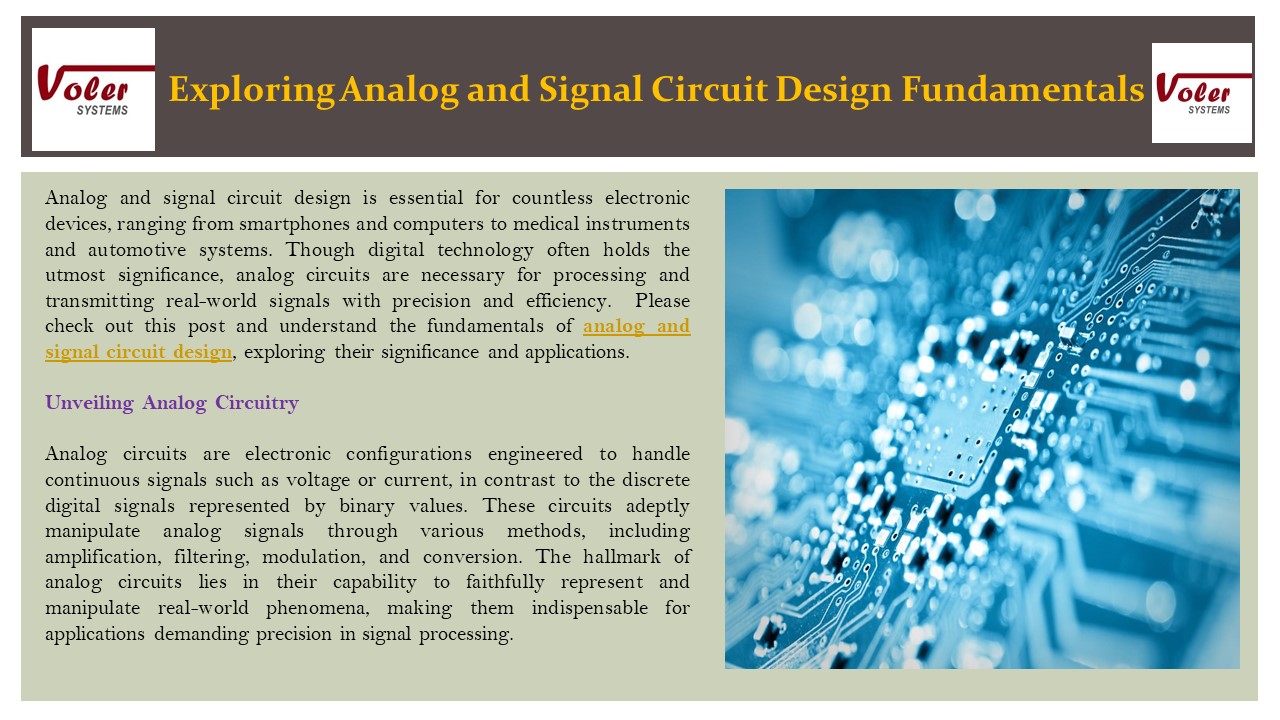Exploring Analog and Signal Circuit Design Fundamentals - PowerPoint PPT Presentation
Title:
Exploring Analog and Signal Circuit Design Fundamentals
Description:
Voler Systems has an extensive successful track record in providing cutting-edge analog circuit design services. We provide accurate and refined conditioning of analog and mixed-signal systems for different sensors including cameras and temperature sensors. For more information about analog circuit design services, please contact us today at – PowerPoint PPT presentation
Number of Views:1
Title: Exploring Analog and Signal Circuit Design Fundamentals
1
Exploring Analog and Signal Circuit
Design Fundamentals
Analog and signal circuit design is essential for
countless electronic devices, ranging from
smartphones and computers to medical instruments
and automotive systems. Though digital technology
often holds the utmost significance, analog
circuits are necessary for processing and
transmitting real-world signals with precision
and efficiency. Please check out this post and
understand the fundamentals of analog and signal
circuit design, exploring their significance and
applications. Unveiling Analog Circuitry Analog
circuits are electronic configurations engineered
to handle continuous signals such as voltage or
current, in contrast to the discrete digital
signals represented by binary values. These
circuits adeptly manipulate analog signals
through various methods, including amplification,
filtering, modulation, and conversion. The
hallmark of analog circuits lies in their
capability to faithfully represent and manipulate
real-world phenomena, making them indispensable
for applications demanding precision in signal
processing.
2
Key Principles of Analog Circuit Design
- Designing analog circuits necessitates a thorough
grasp of fundamental principles and components.
Here are some crucial concepts to consider - Ohms Law This foundational principle elucidates
the relationship between voltage, current, and
resistance within a circuit. - Kirchhoffs Laws Governing the behavior of
current and voltage in electrical circuits,
Kirchhoffs Current Law (KCL) and Kirchhoffs
Voltage Law (KVL) are fundamental to
understanding circuit dynamics. - Component Characteristics Comprehending the
behaviors of passive components such as
resistors, capacitors, and inductors, as well as
active components like transistors and
operational amplifiers (op-amps), is paramount in
analog circuit design. - Frequency Response Analog circuits operate
within specific frequency ranges, necessitating
consideration of frequency-dependent effects like
bandwidth, phase shift, and frequency response.
3
Exploring Signal Circuit Design Signal circuit
design revolves around the transmission and
processing of signals, encompassing a broad
spectrum from audio and video signals to sensor
data and communication signals. These circuits
play a pivotal role in diverse applications such
as telecommunications, audio processing,
instrumentation, and sensor interfacing. Signal
circuit design encompasses a myriad of techniques
and components meticulously tailored to address
specific signal processing requirements.
Applications of Analog and Signal Circuit Design
Audio Amplification Analog circuits play a vital
role in amplifying audio signals for devices such
as speakers, headphones, and other audio
equipment, ensuring enhanced sound quality. Data
Acquisition Signal circuits are employed in data
acquisition systems to convert analog signals
from sensors and transducers into digital data,
facilitating efficient processing and
analysis. Wireless Communication Analog
circuits are integral components of wireless
communication systems, including RF transmitters,
receivers, and modulators/demodulators, enabling
seamless transmission and reception of
signals. Medical Instrumentation Analog
circuits are indispensable in medical devices
such as ECGs, ultrasound machines, and blood
pressure monitors, facilitating the processing
and analysis of vital signals for diagnostic and
monitoring purposes. Automotive Electronics
Analog circuits find applications in automotive
systems for tasks such as engine control, vehicle
diagnostics, and entertainment systems,
contributing to the functionality and performance
of modern vehicles.
4
Analog and signal circuit design is the
fundamental aspect of electrical engineering that
enables the precise processing and transmission
of real-world signals in a comprehensive range of
applications. Using fundamental principles,
components, and design techniques, Voler Systems
engineers can provide analog circuit design
services to accommodate the diverse demands of
modern technology. Though digital systems
continue to advance, the importance of analog and
signal circuit design remains paramount,
integrating the physical world into the digital
counterpart smoothly and effortlessly.
5
THANKS!
Voler Systems
Address - 1021 S Wolfe Rd 285, Sunnyvale, CA
94086, United States City Sunnyvale State Califor
nia Zip 94086 Phone 408-245-9844 Country United
States Website URL https//www.volersystems.com/
Email info_at_volersystems.com
6
(No Transcript)































